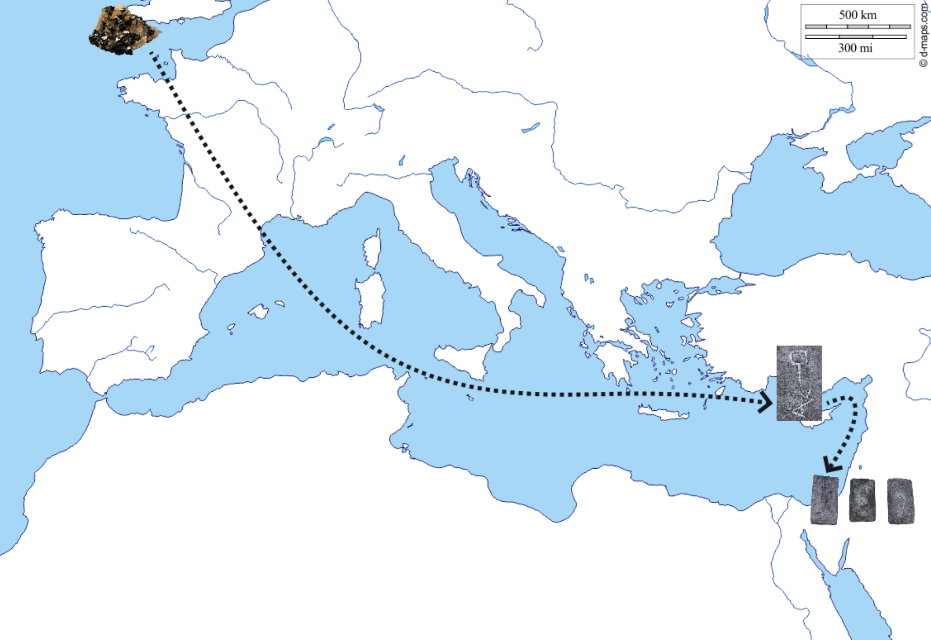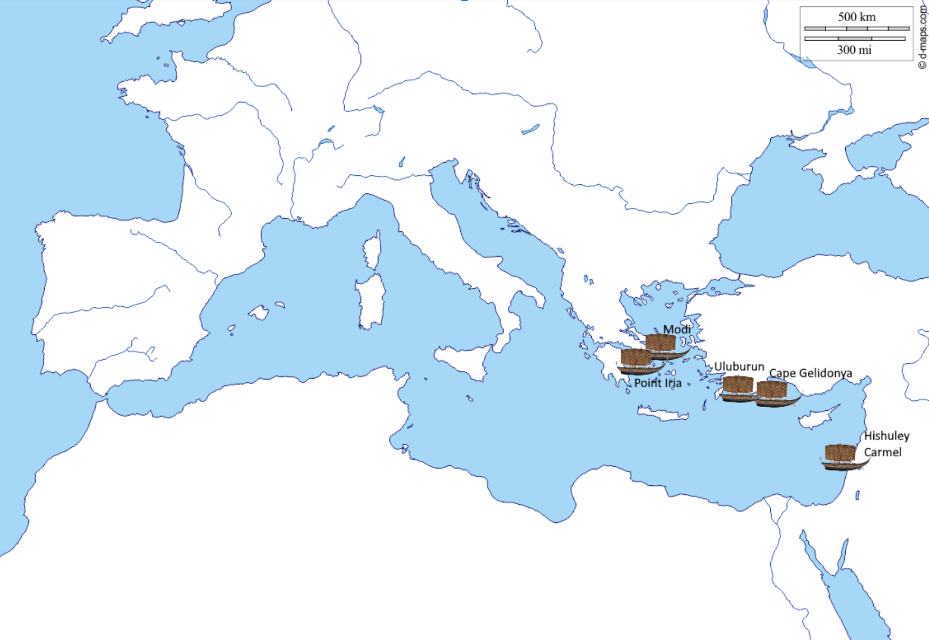An almost global world
- Haifa Tin Ingots
The tin of the Haifa ingots travelled from Cornwall in the UK to the coast of Israel where it ended up on the seafloor. Even though the area today known as Cornwall may ― both geographically and culturally ― seem far away from the Bronze Age Aegean, societies from both areas were part of a larger web of trade networks stretching from the Baltic to the Western Mediterranean and from the Black Sea region to India.
The tin of the Haifa ingots travelled from Cornwall in the UK to the coast of Israel where it ended up on the seafloor. Even though the area today known as Cornwall may ― both geographically and culturally ― seem far away from the Bronze Age Aegean, societies from both areas were part of a larger web of trade networks stretching from the Baltic to the Western Mediterranean and from the Black Sea region to India. From the 15th century BCE onwards, these trade networks emerged as a result of societies’ need for remote resources (like tin) and the technological skills to handle these resources. In order to maintain the ‘international’ trade connections, diplomacy (in the widest possible sense) was needed. The complexity of the Bronze Age Mediterranean diplomatic networks is confirmed by different archives, like the Amarna archive from the time of the famous pharaoh Akhenaten (c. 1350-1330 BCE), and the archives that have been found in Hattuša, the former capital of the Hittite Empire.
The tin trade is a good example of the effects of these long-distance trade networks. In societies heavily dependent on bronze, like in the Bronze-Age Aegean, the very small amount of tin deposits in the Mediterranean posed a major problem. Tin had to be imported from distant areas, like the northern part of the Iberian peninsula, southern England or Central Asia. Although it is impossible to reconstruct ‘tin routes’ in mainland Europe, tin from distant regions was traded internationally across the Mediterranean Sea region, as for instance the cargo of the Uluburun shipwreck shows.
The existence of sea trade in the Late Bronze Age Eastern Mediterranean had since the beginning of Mycenaean studies been assumed on the basis of literary sources, like the texts from the Egyptian Amarna archive, the archives of the Old Assyrian trading posts in Central Anatolia and the Linear B tablets from Greece. There is also iconographic evidence, like the scenes depicting Aegean merchants that have been found in Egyptian tombs. When in 1960 a Late Bronze-Age shipwreck was excavated near Cape Gelidonya, off the southern coast of Turkey, maritime archaeology confirmed the picture of an interconnected trade network in the Eastern Mediterranean. The Late Bronze-Age shipwrecks that have been found in the eastern part of the Mediterranean shed an interesting light on the way in which different societies engaged in international and intercontinental trade as early as the late 14th century BCE.
Currently, five Late Bronze Age shipwreck sites have been investigated in some detail. The most famous and best-preserved is the so-called Uluburun Shipwreck, which was found in 1982 off the southwestern coast of Turkey, near Cape Uluburun, about 65 km west of Cape Gelidonya. The Uluburun Shipwreck is not only the oldest (it has been dated to c. 1330-1300 BCE), but also the richest of the Late Bronze-Age shipwrecks that have been studied: apart from copper and tin ingots in oxhide form, the ship’s cargo included luxury goods, like jewelry (presumably from Egypt), manufactured ivory and pomegranates.
The condition of the other three shipwrecks was rather bad at the time of excavation. The Uluburun and Gelidonya shipwrecks were protected from the current and from looting by the rocky terrain at the seafloor off Turkey’s southwestern coast. The circumstances for preservation off the coast of modern day Israel, where our ingots were found, were less favorable. there.
These Late Bronze Age watery graves offer us a glimpse of the interconnected maritime trade networks of that period. After the so-called Bronze Age Collapse, the political structures that had emerged alongside the international trade networks in the Late Bronze Age largely disappeared, but the rudimentary trade routes remained in operation. The Phoenicians, whose cities came out of the Late Bronze Age Collapse relatively intact, took over sea trade. In doing so, they paved the way for the increased commercial activity between the continents of Africa, Asia and Europe about 800 years later, known as the Ancient Silk Roads Era.

Fig 8: The route that the tin in the Haifa ingots must have travelled before ending up on the seafloor - Map by Cid Swanenvleugel
](https://micrio.thingsthattalk.net/ltKiU/views/max/649x640.s.jpg)
Fig 9: The so-called Rillaton Cup, found in Rillaton Barrow (Krug Reslegh) shows a resemblance to contemporary objects from the Aegean. It has been used as an example for interaction between the tin mining region of Cornwall and the bronze producing centres in the Aegean - Wikimedia

Fig 10: Shipwrecks dating to the Late Bronze Age found in the Mediterranean
](https://micrio.thingsthattalk.net/GnyOy/views/max/640x640.jpg)
Fig 11: A display of part of the jewelry that has been found in the Uluburun Shipwreck - Wikimedia
](https://micrio.thingsthattalk.net/YsapC/views/max/794x640.s.jpg)
Fig 12: A model of the Uluburun Shipwreck - Wikimedia
![Fig 13: The writing tablet that has been found in the Uluburun shipwreck – Photo: The Nautical Archaeology Program https://nautarch.tamu.edu/class/316/uluburun/]](https://micrio.thingsthattalk.net/mZlVo/views/max/640x640.jpg)
Fig 13: The writing tablet that has been found in the Uluburun shipwreck – Photo: The Nautical Archaeology Program https://nautarch.tamu.edu/class/316/uluburun/]